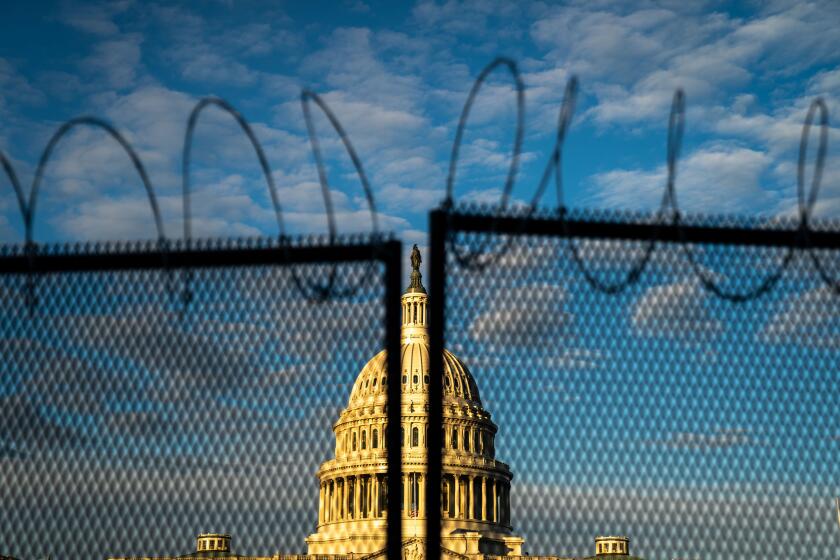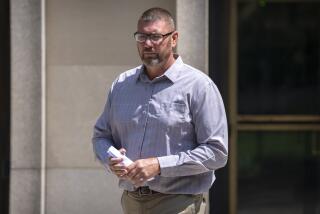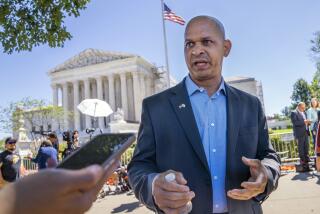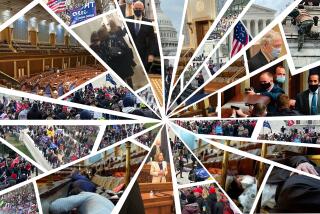The National Guard often responds to natural disasters. It’s seeking to prevent a man-made one at the Capitol
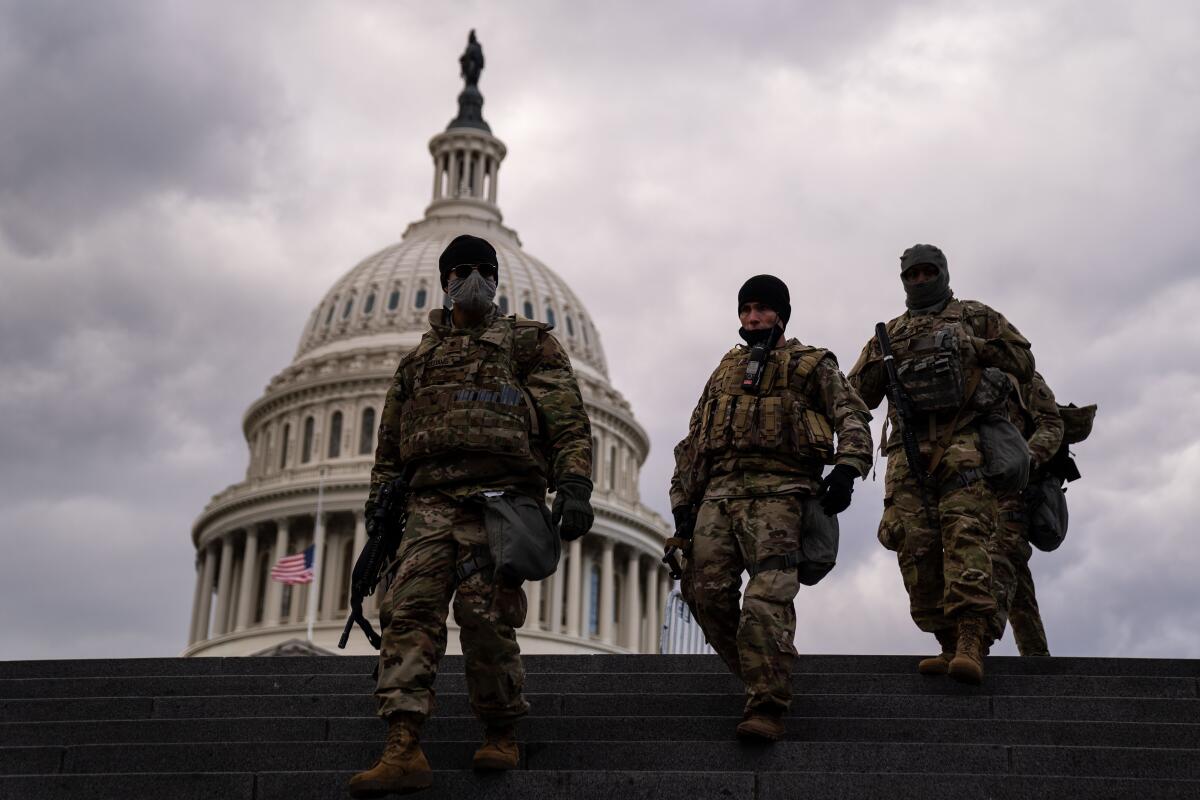
WASHINGTON — Command Sgt. Maj. James Nugent was just like any other American the first time he viewed the inside of the U.S. Capitol. He marveled at the expansive Rotunda and inspected the scars left behind when the British torched the building in 1814.
But Nugent was no tourist listening as a guide described marble statues. His first trip to the Capitol was more a tour of duty, coming just a few days after a violent mob stormed the Capitol on Jan. 6. His guides were Capitol Police officers still mourning the breach that left one of its officers dead from injuries and may be linked to another’s suicide.
Nugent and nearly 25,000 other members of the National Guard have descended upon Washington — some for the first time — to help ensure the safety of the seat of American democracy and the inauguration Wednesday of President-elect Joe Biden.
Nearly every state in the country has plucked members of the Guard from their regular day jobs — as teachers, salesclerks and students — and activated them into duty on Capitol Hill in one of the largest stateside operations in the history of the Guard. With the Capitol Police, these citizen soldiers have transformed Capitol Hill into an American version of Baghdad’s tightly protected Green Zone.
“I really wish it never had to come to this, but I’m really proud that my nation knows that I’m here to protect our way of life,” said Nugent, a member of the Maryland National Guard and the highest-ranking enlisted soldier on the task force overseeing the Capitol.
“As I walk the line and I talk to my soldiers, I remind them that they are not [just] witnessing, that they are a part of history, and 50 years from now when their grandchildren are studying this in school, they will be primary sources to those kids.”
The Guard is typically seen responding to natural disasters such as hurricanes and wildfires, but its mission this week faces unusual risks given the size of the deployment and political divisions that triggered the violence. Army Secretary Ryan McCarthy told the Associated Press on Sunday that officials are vetting members of the National Guard to ensure none of them poses a threat to the inauguration they have been sent to protect.
A dozen members were removed from duty and sent home, Gen. Daniel Hokanson, chief of the National Guard Bureau, said Tuesday.
Ten were flagged by the FBI through standard vetting for participants in the inauguration, one was identified by the chain of command, and another “through anonymous reporting.” Two soldiers were found to have sent inappropriate text messages, but Hokanson did not reveal specifics.
Normally, presidential inaugurations are a constitutional Mardi Gras, but threats have left the nation’s capital in a state of suspicion and anxiety.
Many of the troops are just a few years out of high school or college. Some had never been to the Capitol before they were called up to defend it.
National Guard troops now line the tall, black fences installed around the Capitol complex in the days after the attack. They scan for suspicious drivers on the street or packages left on the sidewalk. Others are helping to staff traffic checkpoints and support local law enforcement. Perhaps most important, they provide a powerful message and image to the millions of Americans who watched coverage of the assault and will watch Biden’s inauguration.
“By and large, we’re just hopefully, hopefully, a comforting presence for the American people,” said Sgt. 1st Class Jon Stresing, also of the Maryland National Guard.
During breaks, troops have been encouraged to see the Capitol and the history it contains.
“Quite frankly, it’s surreal,” Stresing said of seeing the broken glass and debris left behind from the assault. “But my guys are part of history right now, and I wanted them to get over there and see that and explore that and embrace that.”
Rep. Brian Mast (R-Fla.), a veteran who lost his legs in combat, gave troops a tour last week. Other troops quizzed staffers or journalists walking by about the building and its details.
The unsettling sight of troops filing through the Capitol and sleeping on its unforgiving, frigid marble floor provided a stark contrast from recent months, when the halls were often empty as staffers and lawmakers worked from home because of the COVID-19 pandemic. It marks one of the only times soldiers have bivouacked in the Capitol since the Civil War and creates a chilling image for the American public.
“We were disappointed though to see in a variety of images in the media, that Guard personnel are having to take breaks or rest on the floors of the Capitol,” Reps. Rosa DeLauro (D-Conn.) and Betty McCollum (D-Minn.) wrote in a letter to McCarthy, the Army secretary, demanding that they be provided better accommodations.
The cots were in place by the weekend, lining the cafeterias, hallways, Capitol Visitor Center and any other quiet place in the complex. Troops have hotel rooms nearby, but take their rest breaks on site.
Members of Congress quickly opened up the House’s cafeterias to the Guard members and ensured they had access to coffee and doughnuts.
“While a cup of coffee and a donut might not seem that important, these true patriots deserve a little bit of normalcy in the most unnormal of times as they stand on the front lines to protect our nation’s way of governance,” DeLauro and Rep. Tim Ryan (D-Ohio) wrote in an announcement.
Restaurants in the tightknit Capitol Hill neighborhood have donated food to ensure their temporary neighbors don’t have to live on the military’s packaged meals. “The food’s been amazing,” Stresing said. “We’ve been very well fed.”
Times staff writer Molly Hennessy-Fiske contributed to this report.
More to Read
Get the L.A. Times Politics newsletter
Deeply reported insights into legislation, politics and policy from Sacramento, Washington and beyond. In your inbox three times per week.
You may occasionally receive promotional content from the Los Angeles Times.
